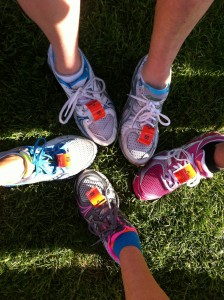A Runner’s Tips for Injury Prevention
 I’m a runner. Not a particularly fast one, but a runner nonetheless. As I get older, I realize how very important it is to be wise about – and respectful – of my body’s limitations. I find that I need constant reminders regarding injury prevention. For instance, I recently went on vacation and did not run for six days. Upon my return I jumped at the opportunity to run a fast(ish) 6-miler with a speedy friend. The result? I was side-lined for days afterward with IB pain (classic “runner’s knee”). Below are some common-sense guidelines that I discovered through a blog called Mommy Run Fast and (when I stick to them) they work for me:
I’m a runner. Not a particularly fast one, but a runner nonetheless. As I get older, I realize how very important it is to be wise about – and respectful – of my body’s limitations. I find that I need constant reminders regarding injury prevention. For instance, I recently went on vacation and did not run for six days. Upon my return I jumped at the opportunity to run a fast(ish) 6-miler with a speedy friend. The result? I was side-lined for days afterward with IB pain (classic “runner’s knee”). Below are some common-sense guidelines that I discovered through a blog called Mommy Run Fast and (when I stick to them) they work for me:
1) The 10% Rule – The single greatest cause of running injuries is over-training. If you want to build mileage, it must be done slowly. The general rule of thumb is no more than a 10% increase in overall weekly mileage. It’s also important to build in cut-back weeks for rest and rebuilding.
2) Add speed work gradually: Our bodies interpret stress both through increased mileage and increased pace, so mileage should stay about the same when you first add speed work. It’s best to start with one hard speed session every week or every other week. As your muscles adapt to the increased work, you can add one speed session and one tempo session per week. Always follow hard days of running with easy days of running or cross training.
3) Get Stronger: I used to think that running was enough strength training for my legs and avoided squats and lunges. This worked fine for years, but when I ventured into the marathon distance, my knees began to give me trouble, largely as a result of weak supporting muscles: quads, hips, and core. After paying more attention to overall strength, the knee pain disappeared.
4) Cross training is another great way to work new muscles and prevent over-use and burnout. You can continue to build your cardiovascular endurance while giving your body a break from the pounding of running. Cycling and swimming are great cross training exercises, but the elliptical, rowing machine, power yoga or hiking is great too. Many people can run 5-6 days a week with no problem, but I’ve found my body is happiest with 3-4 days of running and 2-3 days of other stuff like yoga and mediocre tennis.
5) Rest! Plan at least one rest day every week and take it! Recovery is key to coming back stronger and ready to jump into the next week’s training. I like to use Fridays as a rest day when I run long on Saturday, and follow it with a recovery run Sunday.
6) Love your muscles: After a run or later in the day, take a few minutes to encourage recovery by stretching, and rolling your muscles. The stick or foam roller are great tools for massaging tired muscles and increasing blood flow for less soreness and better recovery. Pay special attention to any body parts that are achy or sore, and use ice, compression and elevation as a preventive measure before an injury sets in.
7) Track your training: Use a journal or an online training tool like daily mile so you can see how your mileage changes over time. You can also use this to track how long you’ve had your shoes so you can replace them every 300 miles or so before the lack of support causes an injury.
8) No comparing! This is a hard one sometimes, but just because a friend handles a quicker pace or 40 miles a week, does not mean your body will be happy doing the same. Know your body. Pay attention to the signs of over-training and take an extra easy day or day off before your body forces you to.
Despite knowing all the rules, I tend to break them more often than I should. It’s a battle to make myself roll out my muscles, and I do push the 10% rule occasionally.























